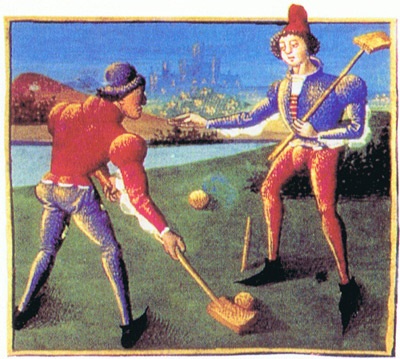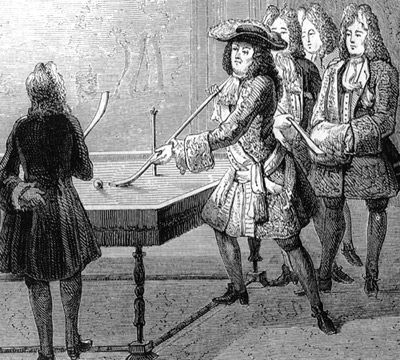In this article, billiards history, we share some interesting facts about this cue sport. Every successful invention has always been named after its inventor. What about printing without Gutemberg or photography without Niepce?
All countries can boast of many writings and engravings dating from the fifteenth century, and like all popular games billiards has progressed, it has changed over time, and very clever is the one who can boast of knowing what the pool was originally…
Billiards History: Started On The Ground
Some school of thought seem to link the pool we know today, to outdoor games such as croquet, which were played on the ground on lawns with curved Crosses (snooker cue) and wooden balls about ten centimeters in diameter.
The playing surface surrounded by small woven hemp walls may be the ancestors of the bands.
A game played on the floor in the 15th century in several countries and under different names: PALLE -MAIL for France, VILORTA for Spain, BOCCIE in Italy and PALL-MALL in England croquet) or the “BALL – YARDS”.
Note the importance of the curved stick, named BALL – YARD in England, BILHARD or BILLARD in France, BIGLIA in Italy and VILORTA in Spain, which gave its name to contemporary billiards.

Billiards on Table
The history of billiards begins under Louis XI. Suffering from back problems, he would have ordered his wood turner a table to play croquet at the height of a man.
The first billiards were simply a table, on which a sheet was placed, and the balls of colors pushed by sticks curved at their ends.
The billiard continues its history and Louis XIII proclaims the end of the transitional period, standing on a billiard table.
The ancestor of modern billiards dates from the 17th century, according to some engravings, one of 1674 (representing a billiard table with 6 pockets with 2 balls and a croquet arch), it was practiced on tables with pockets and with only 2 marbles, an arch called “port” and a keel named the “king”.
It is in 1674 that the first billiard is printed, in English. It appears in the book of C.Cotton: “The compleat Gamester” dixit M.Shamos.
Engravings represent Louis XIV playing billiards, a game then reserved for the nobility. Yet before the French Revolution, it is said that there are in Paris enormously “academies” permanently filled by regulars: players and spectators, masters and amateurs.
The rules were not the same, and the game mixed luck and tactics. Simple rule: the sending of balls in pockets located on the outline of the billiards.

The 18th century saw the development of many kinds of billiards in Europe, Europe in which rooms grow everywhere.
The arch disappears from the table which consisted of a simple board, a green carpet (the grass of the beginning) and wooden bands.
Fabrics were then attached to the edges to improve the rebound of the balls, and the bent stick leaves room for the billiard cue.
The appearance of a third marble (red) and the disappearance of the port and the king (1770) mark the beginnings of a long evolution.
The rules of the game were simple, we gain by dropping the ball of his opponent in the pockets and making pileup.
At the time the billiard was liked and it became popular. There existed in Paris many billiard halls attracting the mass at all times of the day, in order to see the local stars.
A sign of change in the playing style, a color engraving of 1740 representing a billiard table with a green carpet without pocket, can be a source of the origin of the French style in pile-up.
The 19th century was very productive in matter of technical innovations in the service of billiards, which brings this billiard closer to as we know it today.
In 1807 a charter on the billiards of E.White is born, describing the different rules already!!
In 1823, an infantry captain named Mingaud had the incredible idea of fixing a piece of leather on the end of the butt.
The result was that when he got out of prison where he practiced his favorite game, he surprised all the players by the shots he could hit, thanks to its method, particularly the “retro” effect of rolling a ball back.
The improvement of the junction between the tail and the ball, in blue chalk invented by the English John Carr. Called first “white of Spain”, today it is blue.
After the abandonment of the wooden tables for marble and slate, around 1835 the billiard table, made up of a large metal frame, received a slate of 3 to 5 mm in thickness, it replaced the marble.
At the same time, Goodyear unwittingly rendered a proud service to billiards by inventing the rubber, which would later constitute the billiard bands.
In 1850 it was the setting up of the flies on the edge of the bands by the Irish Phelan, a promoter of billiards in the United States.
Then in 1868, it was the invention of the celluloid, good news for animals carrying ivory … even if the billiard was still played with ivory in 1999!
As we can see the history of billiards as we know it today started back in the 17th century.
The bellow video in an instructional tutorial on how to play Pool in 10 minutes.
Two styles that compete
To involve more players around the same table, the English decided the pocketing principles and added marbles.
The number of marbles on the table was continually increasing, and it was decided to put them in a triangle.
The origin of the snooker was located around 1875 in the midst of the colonial period, its popularity became immense, until it became the national sport in all countries of the former Commonwealth.
In France the players favored the pileups and therefore suppressed the pockets.
The talent of the players was such that the series became too long and the public saw very little balls move: they then designed frames on billiards and invented games where pileup is valid only if there are bands.
It is in the US that billiards finds its letters of nobility … Arrived around 1800, billiards developed very quickly throughout the country, generating real spectacles attracting hundreds of spectators, coming to see the endless series of French against Americans.
Two types of billiards cohabited, the Pileup and the Pool: thus giving champions like Alferd de Oro, (born in Cuba) champion of Pool and 3 Bands in 1910, 1911 and 1913.
From 1890 to 1930 billiards developed dramatically thanks to technical innovations and improved rules of the game.
The pileup billiards is disaffected by the public because of the too great mastery of the players.
J.Schaefer realizing 690 of series in 1879 and the inexhaustible W.Hoppe (1887-1959) who could at 14 years realize 2000 points to the ” Free “, brought the players to the 3 Bands, more complicated.
Mastered by the Americans until 1938, the 3 bands (professional sports) returned to his home country during the final of the World Championship in Paris, where Roger Conti annihilated all his opponents to 1,103 of general.
The Pool
Its evolution took place during a championship where the winner only entered the balls numbered 11 to 15 (the Points were according to the number on the ball).
A spectator of the room proposed to replay the final giving 1 Point per ball. The “14-1” was born: the only official game mode until 1960 when the game of 9 was introduced in competition.
